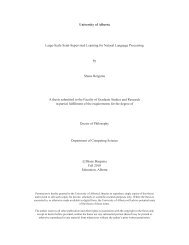The high altitude wildlife areas of western Arunachal Pradesh
The high altitude wildlife areas of western Arunachal Pradesh
The high altitude wildlife areas of western Arunachal Pradesh
You also want an ePaper? Increase the reach of your titles
YUMPU automatically turns print PDFs into web optimized ePapers that Google loves.
Chapter 2<br />
Table 2. A comparison <strong>of</strong> mammalian species richness (see Table 4 for scientific names) in the six <strong>high</strong><br />
<strong>altitude</strong> regions <strong>of</strong> Tawang and West Kameng Districts, <strong>Arunachal</strong> <strong>Pradesh</strong>. <strong>The</strong> table also indicates the<br />
global importance <strong>of</strong> the species in terms <strong>of</strong> their conservation status in the IUCN’s Red List <strong>of</strong> Threatened<br />
Species.<br />
SPECIES<br />
IUCN RED LIST STATUS<br />
UPPER<br />
NYAMJANG CHU<br />
LOWER<br />
NYAMJANG CHU<br />
PTSO<br />
MUKTO<br />
MAGO CHU<br />
HIGH ALTITUDE<br />
WEST KAMENG<br />
Barking deer + + + + + +<br />
Bharal* + - + - + +<br />
Chinese goral* Vulnerable - - . - + .<br />
Chinese Pangolin Low risk near threatened . . . . . +<br />
Clouded leopard Vulnerable . . . . . +<br />
Common Leopard + + + + + +<br />
Hairy footed flying squirrel* Low risk near threatened . . + . . .<br />
Himalayan black bear* Endangered + . + + + +<br />
Himalayan goral* Low risk near threatened + + + + + +<br />
Himalayan marmot* Low risk conservation dependent + + + - + .<br />
Himalayan palm civet* . + . . . .<br />
Himalayan striped squirrel* + + . + + +<br />
Large eared pika* . + . . + +<br />
Leopard cat + + . . . .<br />
Macaque + + . + + +<br />
Marbled cat Vulnerable . . . . . +<br />
Moupin's pika* . . . . + +<br />
Musk deer* Low risk near threatened + + + - + +<br />
Orange bellied Himalayan squirrel* . + . + + +<br />
Otter Endangered + . . . . .<br />
Pale weasel* . . . - . +<br />
Porcupine ? . . . + . .<br />
Red goral* Vulnerable . . . - . +<br />
Red panda* Endangered + + + + + +<br />
Rhesus macaque . . . . . +<br />
Sambar + + . + + +<br />
Serow* Vulnerable + + + + + +<br />
Slow loris Data deficient + . . . . .<br />
Snow leopard* Endangered . . + - + .<br />
Takin* Vulnerable - - - - . +<br />
Tiger Endangered - - - - - -<br />
Wild dog Vulnerable . + + + + +<br />
Wild pig + . + + + +<br />
Yellow throated marten* . . . . + +<br />
Total species 16 15 13 13 20 24<br />
skins (especially goral Nemorhaedus sp. and barking deer) are traded and used locally<br />
by herders as clothing (both trousers and jackets are stitched; Appendix 1). Marmots<br />
Marmota himalayana are killed for the reported medicinal value <strong>of</strong> their skin and fat<br />
in treating backaches.<br />
In many <strong>of</strong> the surveyed <strong>areas</strong>, villagers reported that hunting intensity had<br />
declined following the Buddhist spiritual leader, the Dalai Lama’s visit to Tawang in<br />
May 2003. Although we found widespread evidence <strong>of</strong> continued hunting (fresh kills<br />
<strong>of</strong> bharal Pseudois nayaur, takin Budorcas taxicolor and pheasants, a two month old<br />
skin <strong>of</strong> a snow leopard that was caught in a snare, abundant snares for musk deer,<br />
12

















